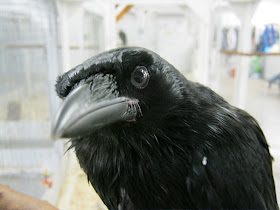During the summer, the Educational Training Center (ETC) the World Bird Sanctuary’s behind the scenes bird housing facility, is a pretty quiet place.
We take care of the few birds that do not end up out at a summer zoo show, and we take care of a lot of maintenance projects for WBS, such as filling potholes on the road to the ETC, or maintaining much of the behind the scenes bird housing.
However, when the first week of September rolls around, the ETC gets much noisier. This year, WBS sent two groups of birds and trainers on the road—one group to the Milwaukee County Zoo in Wisconsin, and another to the Stone Zoo in Boston, Massachusetts. Both birds and staff performed spectacularly at these zoos all summer.
Grand finale of WBS Birds of Prey show at Boston's Stone Zoo
On September 7th, the Milwaukee zoo show returned to St. Louis, bringing with it about eighteen birds. Then on September 10th, the Boston zoo show returned with another eighteen birds. In the space of four days, the ETC went from being calm and quiet to a hub of activity. We have a lot more birds to take care of down here now, and we love having them back!
The daily routine starts by checking to make sure all of our birds are okay in the morning. They usually greet us in their stalls with their signature noises—the peeping of our young Augur Buzzard, the grunting bark of a Tawny Eagle and the shrieking chirp of two Bald Eagles. The Parrot Room, where all of our parrots are housed, is another level of noise entirely. The parrots shriek loudly, and we even have to wear hearing protection. They’re hungry, and they’re not going to let you forget it. We feed the parrots first, then we take the raptors outside, so they can experience whatever weather happens to be going on that day.
The morning passes in a flurry of food prep. On a typical day, we have to prepare at least thirty individual bird diets. Some birds can only get specific types of food (for example, pelicans will only eat fish). Some of our birds are weight managed, which means they are either performing in shows or learning a new behavior and need to maintain a specific weight: the weight at which they perform best (Goober the Black Vulture and Lenore the White-necked Raven are two such birds). Other birds can eat whatever they want—we can feed our Bald Eagles rabbit, rat, fish or venison (although Patriot, one of our eagles, doesn’t like to eat fish, which is atypical of a Bald Eagle, really…)
Here at the ETC we also prepare food for the Display line on the main site. This adds another thirty or so birds for which we must prepare the right diet. We add a nutritional supplement to the food called Vitahawk. This gives the birds extra vitamins and nutrients that are necessary for their health. After the Vitahawk is added, the birds are ready to be fed.
When we walk out into the weathering area with the green tray, all of the birds get excited. They know what that means: feeding time! The bird that gets the most excited is Prius, our Gyrfalcon-Peregrine Falcon hybrid. She chirps constantly, from the moment the weathering area is opened to the instant she gets her food. Like most falcons, Prius’s favorite food is quail. As soon as she has the food in her grip, she starts to chow down.
Other birds are more reserved about eating. Liberty the bald eagle will sometimes just stare at his fish or his rat, seemingly wondering what he is supposed to do with it. More often than not, when we leave the weathering area, he has hopped down from his perch and started to eat. By the time all the birds are fed, all the food is prepared and the kitchen is cleaned, it is time for the humans to have lunch.
After lunch, we have to make sure that all of the birds have a clean place to live and play and sit for the night. Some of the birds stay in mews inside the ETC, especially those species that are not adapted to live in cold weather (Red-legged Seriema, African Pied Crow, etc.) We spot clean these enclosures, taking out wet or dirty aspen shavings on a daily basis. We also replace all of the aspen shavings in the mews regularly. Sometimes the ravens and crows try to “help”—they attack the broom while we sweep. Mostly, the birds sit on their perches and give us strange looks. We also make sure to clean out the raptor room—the place where the raptors that are on anklets and jesses stay during the night.
After we clean up after the birds, we take care of any other maintenance that is needed behind the scenes. We are a busy group of people down here at the ETC.
Here are just a few of the birds we take care of:
Baton Rouge, King Vulture
Osiris, Egyptian Vulture
Patriot, Bald Eagle
Prius, Gyrfalcon-Peregrine Falcon hybrid
Some of these birds, like Patriot the Bald Eagle, will be rotated up to the Nature Center and Weathering areas from time to time, or will participate in educational programs over the winter. Others, particularly those who are cold sensitive, will enjoy the heated quarters in the ETC building and will not be on public display until next summer when they will again be traveling to zoos and other entertainment venues. For right now these birds are enjoying their winter vacation and the ETC staff is gearing up for a very busy winter.







No comments:
Post a Comment